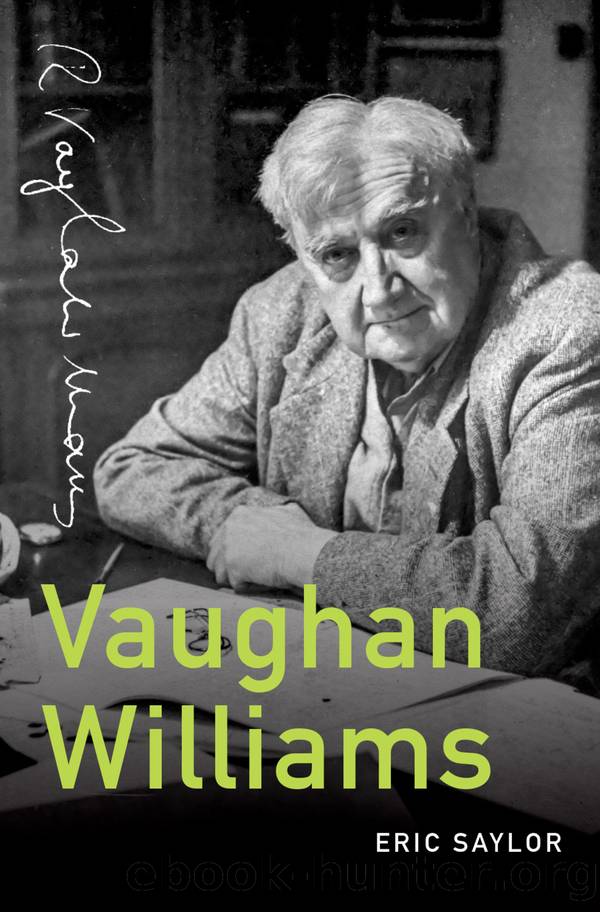Vaughan Williams by Eric Saylor

Author:Eric Saylor
Language: eng
Format: epub
Publisher: Oxford University Press
Published: 2022-01-15T00:00:00+00:00
Example 14.2 Symphony (No. 5) in D Major, mvt. 1, mm. 1â8
Neither is quite correct. Instead, just as the Mass in G Minor technically wasnât, this Symphony in D Major is âaboutâ D major, in the sense of âapproximately.â The first eight measures feature a D Mixolydian collection, shifting to D Dorian when the clarinets lower the F⯠to Fâ® in m. 9. But while the mode remains the same, its central pitch shiftsâfirst exquisitely to F in m. 40, then five measures later to Câwhich means âthe continuing pedal note becomes the fifth degree and finally the tonic,â resolving the tension established from the outset.34 But then, without warning, Vaughan Williams makes a pivot as breathtaking as the initial choral entrance in A Sea Symphony or the minor-to-major transformation preceding the trumpet cadenza in the Pastoral: the C Dorian modality is abandoned for the radiance of E major, a mediant modulation flanking and subtly positioning D as the fulcrum upon which the entire harmonic structure balances.
What is particularly remarkable about this design is its economy of means. The Fourth Symphony may have been an acrimonious homage to Beethoven, but it is the Fifth that, in the first movementâs rigorous exploration of a very limited amount of motivic material, is a more fitting tribute. But Vaughan Williams acknowledged a different composer in his dedication: Jean Sibelius, whose influence may be gleaned in the string writing of the Preludioâs central section (one hesitates to call it a development), or in the deeply moving English horn solo at the beginning of the Romanza. This same passage sounds in The Pilgrimâs Progress when Pilgrim arrives at the House Beautiful, one of the many concordances that commentators have seized upon to interpret this work, but this effort seems unnecessary. As we have seen many times, Vaughan Williams insisted upon splitting inspiration from interpretation. âIt matters, of course, enormously to the composer what he was thinking about when he was writing a particular work,â he said in 1919, âbut to no one else in the world does it matter one jot.â35 He returned to this theme in a later tribute to Elgar. âThe best composer is surely he who has the most beautiful melodies, the finest harmony, the most vital rhythm, and the surest sense of form,â he wrote. âI lose patience with those people who try to put up Berlioz as a great composer . . . because he could give literary reasons for his beliefs, and do not see that a composer like DvorËák, a reed shaken by the wind, is far the greater man of the two because the wind was the divine afflatus.â36
Divinely inspired or otherwise, Vaughan Williamsâs mastery of his craft is apparent throughout this symphony, whether in the finely wrought harmonic design of the Preludio, the Scherzoâs Mendelssohnian sprightliness, the Romanzaâs intensely passionate lyricism, or the imaginatively flexible treatment of form in the closing Passacaglia, which brilliantly reprises the Preludioâs opening material to launch a coda that ranks among the most delicately beautiful passages of music Vaughan Williams ever wrote.
Download
This site does not store any files on its server. We only index and link to content provided by other sites. Please contact the content providers to delete copyright contents if any and email us, we'll remove relevant links or contents immediately.
| France | Germany |
| Great Britain | Greece |
| Italy | Rome |
| Russia | Spain & Portugal |
Fanny Burney by Claire Harman(26531)
Empire of the Sikhs by Patwant Singh(22980)
Out of India by Michael Foss(16792)
Leonardo da Vinci by Walter Isaacson(13189)
Small Great Things by Jodi Picoult(7024)
The Six Wives Of Henry VIII (WOMEN IN HISTORY) by Fraser Antonia(5400)
The Wind in My Hair by Masih Alinejad(5034)
A Higher Loyalty: Truth, Lies, and Leadership by James Comey(4851)
The Lonely City by Olivia Laing(4751)
The Crown by Robert Lacey(4731)
Millionaire: The Philanderer, Gambler, and Duelist Who Invented Modern Finance by Janet Gleeson(4386)
The Iron Duke by The Iron Duke(4294)
Papillon (English) by Henri Charrière(4199)
Sticky Fingers by Joe Hagan(4106)
Joan of Arc by Mary Gordon(4022)
Alive: The Story of the Andes Survivors by Piers Paul Read(3970)
Stalin by Stephen Kotkin(3883)
Aleister Crowley: The Biography by Tobias Churton(3589)
Ants Among Elephants by Sujatha Gidla(3417)
